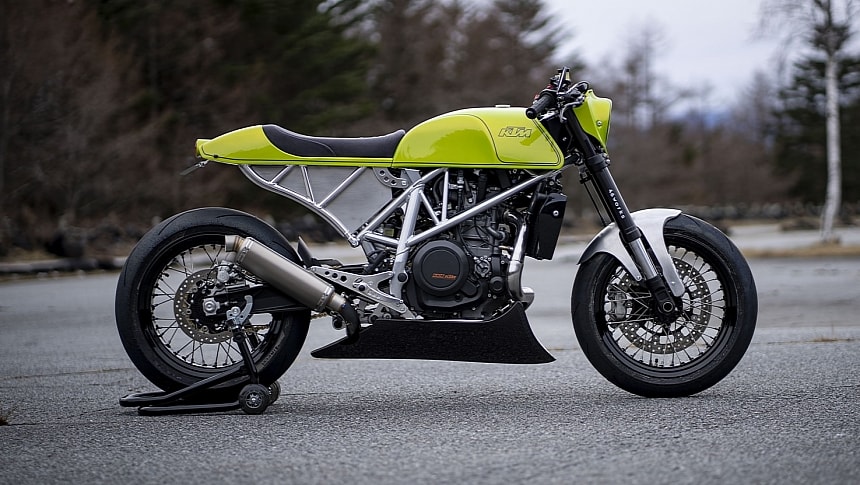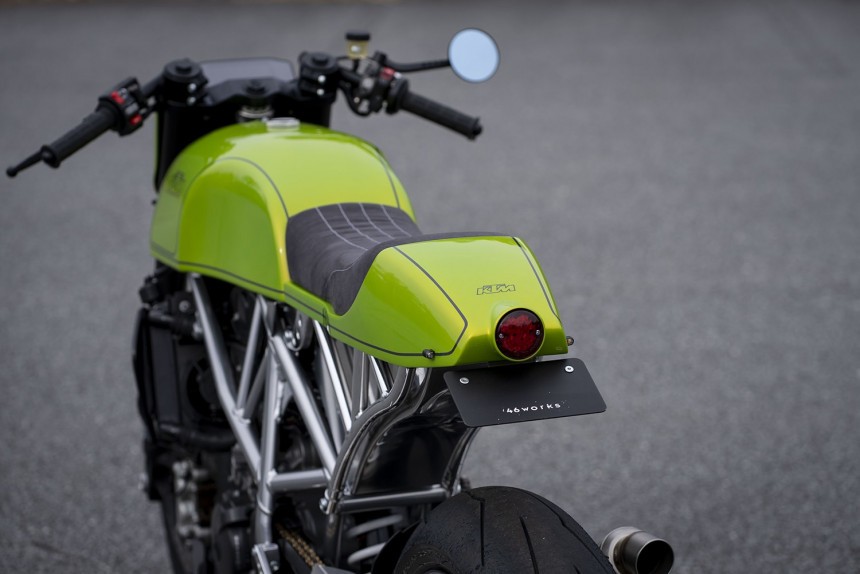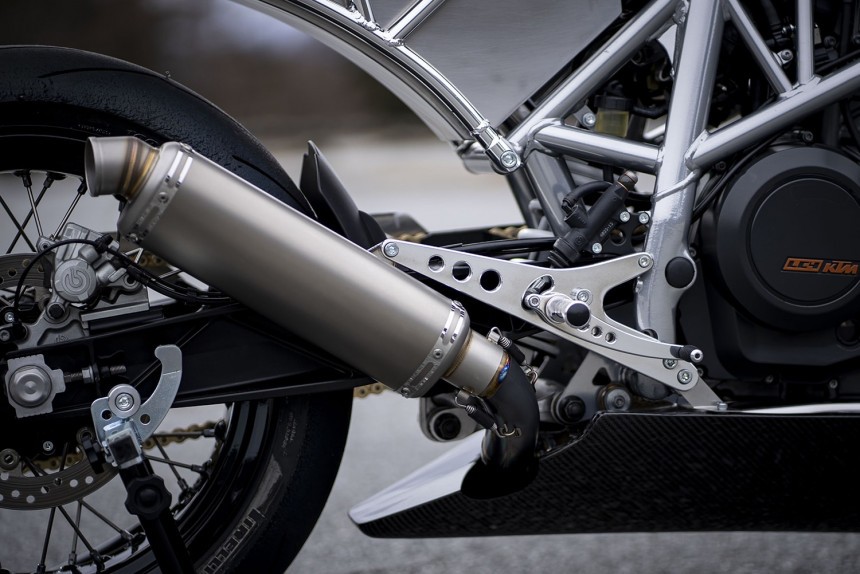Shiro Nakajima doesn’t need much of an introduction nowadays, because we’ve talked about his custom projects many times before. He runs 46Works as a solo endeavor in rural Japan, building all manner of bespoke two-wheelers you can’t help but fall in love with. Shiro had been rather fond of the LC4 platform from KTM for well over a decade, and he finally got the chance to experiment with it in 2023.
After getting his hands on a 690 Duke from the model-year 2017, he racked up a few miles on its odo to get a feel of what could be improved. The mid-sized KTM is brought to life by a 690cc single boasting 12.6:1 compression, four valves, and a Keihin fuel injection system. In terms of power output, the thumper has 73 ponies and 54 pound-feet (74 Nm) of torque to play with.
This grunt travels to the rear wheel via a six-speed gearbox and a slipper clutch. Suspension duties are assigned to premium WP componentry fore and aft, while stopping power comes from drilled brake discs and Brembo calipers with Bosch ABS. On an empty stomach, the 690 Duke weighs in at just 327 pounds (148 kg), so it’s an absolute blast to zoom around on while pulling the occasional wheelie.
Seeing how well-behaved the motorcycle was during his test rides, Nakajima-san decided not to mess with the things that already worked. The running gear and engine internals have thus remained unchanged, and most of the elbow grease went into the cosmetic side of things. Upon arrival at his shop, the Duke was promptly stripped of its OEM bodywork, wheels, and subframe.
Then, the transformation got underway in the footwear department, where you will now find a pair of laced hoops hailing from a different KTM model. Both rims are cloaked in sticky Diablo Supercorsa rubber from Pirelli, offering plentiful grip for spirited riding. With the unsprung sector taken care of, Shiro’s next port of call was the bike’s bodywork.
Using aluminum sheets and traditional metal-shaping techniques, he came up with a svelte cafe racer attire to completely alter the donor’s appearance. His starting point was the fuel tank – a retro-looking masterpiece featuring stylish knee indentations and impeccable contours. The rest of the attire was shaped around this new tank, but our protagonist had to make some intricate structural changes at the back before he could proceed with the bodywork fabrication.
A custom subframe was needed to achieve a perfectly level bone line, so the man wasted no time crafting a neat trellis module from scratch. Encased between the steel tubes is a sizeable alloy structure housing the airbox and electronics, while also acting as a rear fender of sorts. Up top, we’re greeted by a handmade cafe racer tail unit, whose southernmost tip is home to LED lighting and a small license plate bracket.
You will also see an elegant saddle in that area, hailing from the upholstery gurus over at Razzle Dazzle. At the front end, Shiro fitted a handsome headlight nacelle bearing aftermarket LED componentry within. He fabricated sporty front fender, as well, but the carbon fiber belly pan beneath the engine was supplied by Future Craft. Furthermore, the creature’s ergonomics are a pretty big departure from its stock configuration.
Tailor-made rearsets are partially responsible for this, and they’re complemented by Battle Factory clip-ons in the cockpit. These replacement handlebars flank a CNC-machined top clamp, which is placed right behind the 690 Duke’s original dash. We notice a single rear-view mirror on the right-hand side, while the front turn signals live in close proximity to the lower triple clamp.
Master Nakajima might’ve left the single-cylinder mill as it was on the inside, but he did install some fresh exhaust pipework. The plumbing is made out of titanium for the sake of further weight reduction, ending right beside the swingarm on the right. Nearby, there is also a small rear wheel hugger offering some additional protection against road debris. The last piece of the puzzle had to do with the paint job.
The process was outsourced to Drops Design Works for the best possible result, and it saw the upper bodywork cloaked in a gorgeous layer of lime green. Black pinstripes and KTM logos accompany the base color, but the snazzy finishes don’t end there. Various other bits were painstakingly polished to really bring out that shine, including the entire trestle frame and front fender.
On the other hand, the rims got finished in black and the belly pan was left unpainted to expose the carbon fiber. White 46Works logos can be spotted on the fork stanchions, contrasting rather nicely against the black background. For many builders out there, the Duke’s standard anatomy makes it very difficult to create a quintessential cafe racer, but Shiro Nakajima clearly nailed it!
This grunt travels to the rear wheel via a six-speed gearbox and a slipper clutch. Suspension duties are assigned to premium WP componentry fore and aft, while stopping power comes from drilled brake discs and Brembo calipers with Bosch ABS. On an empty stomach, the 690 Duke weighs in at just 327 pounds (148 kg), so it’s an absolute blast to zoom around on while pulling the occasional wheelie.
Seeing how well-behaved the motorcycle was during his test rides, Nakajima-san decided not to mess with the things that already worked. The running gear and engine internals have thus remained unchanged, and most of the elbow grease went into the cosmetic side of things. Upon arrival at his shop, the Duke was promptly stripped of its OEM bodywork, wheels, and subframe.
Then, the transformation got underway in the footwear department, where you will now find a pair of laced hoops hailing from a different KTM model. Both rims are cloaked in sticky Diablo Supercorsa rubber from Pirelli, offering plentiful grip for spirited riding. With the unsprung sector taken care of, Shiro’s next port of call was the bike’s bodywork.
A custom subframe was needed to achieve a perfectly level bone line, so the man wasted no time crafting a neat trellis module from scratch. Encased between the steel tubes is a sizeable alloy structure housing the airbox and electronics, while also acting as a rear fender of sorts. Up top, we’re greeted by a handmade cafe racer tail unit, whose southernmost tip is home to LED lighting and a small license plate bracket.
You will also see an elegant saddle in that area, hailing from the upholstery gurus over at Razzle Dazzle. At the front end, Shiro fitted a handsome headlight nacelle bearing aftermarket LED componentry within. He fabricated sporty front fender, as well, but the carbon fiber belly pan beneath the engine was supplied by Future Craft. Furthermore, the creature’s ergonomics are a pretty big departure from its stock configuration.
Master Nakajima might’ve left the single-cylinder mill as it was on the inside, but he did install some fresh exhaust pipework. The plumbing is made out of titanium for the sake of further weight reduction, ending right beside the swingarm on the right. Nearby, there is also a small rear wheel hugger offering some additional protection against road debris. The last piece of the puzzle had to do with the paint job.
The process was outsourced to Drops Design Works for the best possible result, and it saw the upper bodywork cloaked in a gorgeous layer of lime green. Black pinstripes and KTM logos accompany the base color, but the snazzy finishes don’t end there. Various other bits were painstakingly polished to really bring out that shine, including the entire trestle frame and front fender.
On the other hand, the rims got finished in black and the belly pan was left unpainted to expose the carbon fiber. White 46Works logos can be spotted on the fork stanchions, contrasting rather nicely against the black background. For many builders out there, the Duke’s standard anatomy makes it very difficult to create a quintessential cafe racer, but Shiro Nakajima clearly nailed it!















